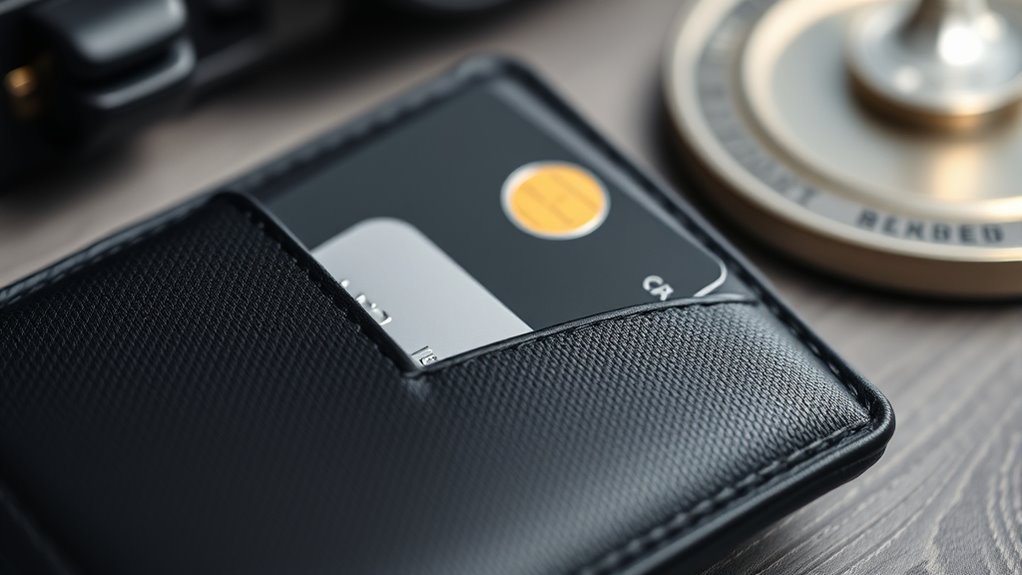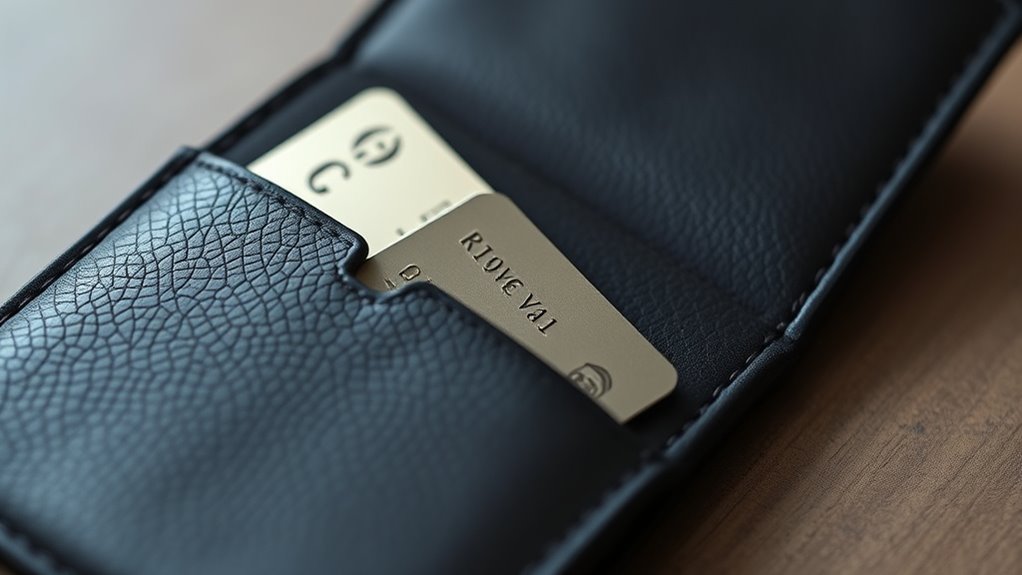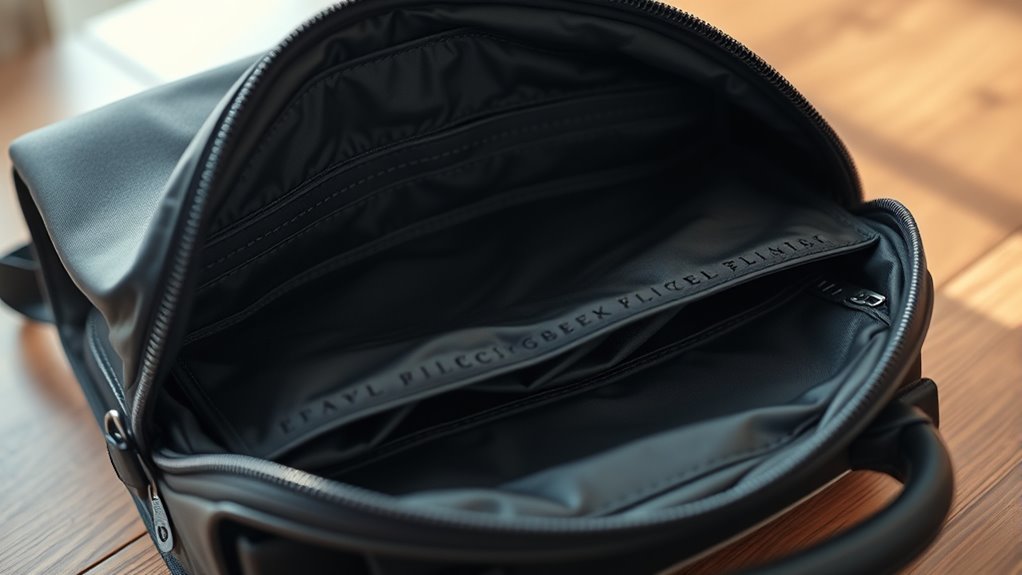RFID‑blocking pockets can offer a helpful layer of protection by preventing electronic pickpocketing and unauthorized scans of RFID chips in your cards or documents. However, their effectiveness is limited; they don’t guarantee complete security and can create a false sense of safety. Environmental factors and the quality of the pocket matter too. To understand whether these pockets suit your needs and how to maximize your security, explore the details below.
Key Takeaways
- RFID-blocking pockets create a barrier to disrupt radio signals, but their effectiveness varies by quality and design.
- They offer limited protection, mainly when items are directly inside, and can’t prevent all forms of RFID-related threats.
- Using RFID-blocking pockets can provide a sense of security but should be combined with other security practices.
- No solution guarantees 100% security; vigilance and additional measures remain essential for comprehensive protection.
- Their necessity depends on individual risk exposure, travel habits, and the specific items you want to protect.
How RFID Technology Works and Its Risks

RFID technology uses radio waves to automatically identify and track objects, such as your credit cards or passports. These radio signals enable quick data transfer without physical contact, making transactions faster. However, this convenience comes with risks to your RFID privacy. Hackers can exploit vulnerabilities through RFID hacking, using devices to intercept signals and access personal information without your knowledge. If your RFID-enabled cards aren’t protected, you could be vulnerable to identity theft and fraud. While RFID technology offers efficiency, it’s important to understand its potential security gaps. Being aware of these risks helps you take steps to safeguard your data, especially when handling sensitive items. Vetted – HARTSBURG NEWS highlights the importance of awareness and security measures. Protecting against RFID hacking is essential in today’s digital age, making RFID-blocking solutions a worthwhile investment.
The Science Behind RFID‑Blocking Materials

Understanding how RFID-blocking materials work starts with recognizing the science behind their ability to disrupt radio signals. These materials employ RFID shielding techniques, which prevent electromagnetic waves from reaching your RFID chips. The key lies in their material composition, often involving conductive metals like aluminum, copper, or stainless steel woven into fabrics or coatings. When properly integrated, these materials create a barrier that absorbs or reflects radio waves, stopping unauthorized scans. Additionally, the effectiveness of RFID blocking is influenced by the material weave, which affects how well signals are attenuated.
RFID-blocking materials use conductive metals to absorb or reflect signals, preventing unauthorized scans.
- Conductive metals form the core of RFID shielding fabrics
- The weave or coating determines effectiveness
- Thinner materials can still block signals effectively
- Material composition impacts durability and flexibility
- Properly designed shielding disrupts RFID signals without harming your device
Common Items That Use RFID Chips

Have you ever wondered where RFID chips are hiding in everyday items? Many common items, like credit cards, passports, and driver’s licenses, contain RFID chips that enable quick scanning and validation. Some store loyalty cards and access badges also use RFID technology for convenience. While these features improve efficiency, they can compromise your RFID privacy if not protected. Thieves can exploit RFID chips for electronic theft, stealing personal information without your knowledge. Even smartphones and certain clothing labels may contain RFID tags. Being aware of these items helps you decide if you need RFID-blocking solutions. Protecting your personal data is essential, especially as RFID technology becomes more integrated into daily life, increasing the risk of unauthorized scanning and privacy breaches. Additionally, market trends indicate a shift toward healthier snack options in vending machines, reflecting changing consumer preferences.
Effectiveness of RFID‑Blocking Pockets

RFID-blocking pockets are designed to prevent unauthorized scanning of your RFID-enabled cards and devices. Their effectiveness in protecting your RFID privacy depends on the quality of the materials and construction. High-quality pockets create a Faraday cage that blocks RFID signals, making electronic theft much harder. However, cheaper or poorly made pockets might not offer complete protection, leaving gaps that thieves can exploit. When choosing one, consider these points:
- Material quality and durability
- Compatibility with your cards and devices
- Ease of access and usability
- Reviews and user feedback
- Level of security against electronic theft
While RFID-blocking pockets can considerably reduce the risk of electronic theft, no solution guarantees 100% security. They’re useful tools, but it’s crucial to stay vigilant and combine them with other security measures. Additionally, selecting a flat iron bike material designed for durability can enhance the longevity of your RFID-blocking pocket.
Situations Where RFID Protection Matters Most

You’re most at risk of RFID skimming during airport security checks, where your passport and boarding passes are scanned. International travel also increases exposure to potential data theft in unfamiliar environments. Public transportation settings, like buses and subways, can expose your RFID-enabled cards to unwanted readers in crowded spaces. Additionally, voiceover skills can be leveraged to create compelling security warnings and educational content about RFID protection.
Airport Security Checks
When passing through airport security, protecting your RFID-enabled cards becomes especially crucial because scanners can read your information without your knowledge. This raises privacy concerns, as sensitive data could be accessed without your consent. RFID skimming at security checkpoints can bypass data encryption, risking identity theft or fraud. To prevent this, consider shielding your cards with RFID-blocking pockets or sleeves. Additionally, using specialized accessories designed for RFID protection can enhance security during travel. Some key points to remember:
- Security scanners can read RFID chips silently
- Sensitive info might be accessed without your knowledge
- RFID-blocking helps maintain your privacy during checks
- Data encryption isn’t foolproof against skimming
- Using protective gear ensures peace of mind during travel
Staying vigilant about RFID security lets you travel confidently, knowing your info stays safe.
International Travel Risks
International travel exposes your RFID-enabled cards to unique risks, especially in crowded airports, train stations, and busy urban areas where scanners are more prevalent. Thieves can use RFID readers to skim your card data without your knowledge, threatening your digital privacy. Without protection, your sensitive information isn’t just vulnerable to theft but also to potential misuse. RFID-blocking pockets help preserve data encryption, making it harder for criminals to access your card details. In high-traffic environments, the risk of accidental data interception increases, so taking precautions is wise. Using RFID-blocking solutions ensures your digital privacy remains secure during your travels, giving you peace of mind and reducing the chances of unauthorized access to your financial and personal data.
Public Transportation Environments
Public transportation environments, such as buses, subways, and train stations, are hotspots for RFID skimming because they bring large crowds into close proximity with potential thieves. As you navigate urban mobility, your ticketing systems and contactless cards are vulnerable to unauthorized scans. These settings make it easy for someone to discreetly harvest your data while you focus on your commute. Protecting your RFID-enabled cards is essential to prevent identity theft or financial loss.
Consider these risks:
- Pocket thefts during crowded rides
- Unauthorized access to your contactless payment cards
- Skimming at ticketing kiosks
- Data breaches in transit card systems
- Loss of control over your personal travel info
Limitations and Potential False Security

RFID-blocking pockets might give you a false sense of security, but they aren’t foolproof. Their protection range is limited, so nearby scanners outside the pocket can still access your data. Overconfidence in these pockets could lead you to ignore other essential security measures. Recognizing that manipulative behaviors can occur even when one feels protected is important for maintaining overall security awareness.
False Sense of Security
While RFID-blocking pockets can provide a sense of security, they are not foolproof and can create a false sense of protection. Relying solely on them might make you think your identity theft risks or digital privacy concerns are fully managed, which isn’t true. Thieves can still compromise your information through other methods, like hacking or social engineering. Plus, RFID-blocking only protects certain frequencies, and not all data theft involves RFID signals. Additionally, some individuals may exhibit overconfidence in security measures, which can lead to neglecting comprehensive security practices.
Be cautious about feeling invincible:
- Assuming your cards are completely safe
- Ignoring other important security measures
- Overestimating RFID-blocking effectiveness
- Forgetting hackers use multiple tactics
- Relying solely on pockets for protection
True security involves multiple layers, not just RFID-blocking pockets.
Limited Protection Range
Although RFID-blocking pockets can prevent certain signals from being intercepted, their protection range is limited and doesn’t cover all potential threats. The signal range of these pockets is typically short, often only blocking RFID signals when your card is directly inside. This means that if an attacker is nearby or the signal is strong enough, they might still access your information outside the pocket’s protection zone. Additionally, interference issues can weaken the effectiveness of RFID-blocking materials, especially in crowded environments with multiple electronic devices. As a result, you shouldn’t rely solely on these pockets for complete security. They provide a basic layer of defense, but their limited signal range leaves gaps that savvy thieves could exploit. Always consider other security measures to ensure your personal data stays protected. Understanding signal interference can help you assess how environmental factors might impact RFID security.
Potential for Overconfidence
Despite their ability to block certain RFID signals, these pockets can create a false sense of security. The overconfidence bias might lead you to believe your cards are fully protected, but that’s not always true. This security complacency can cause you to overlook other vulnerabilities or risky behaviors. You may assume that simply using an RFID-blocking pocket keeps you safe from all threats, but scammers often find new ways around these barriers. Additionally, the reliance on cookie preferences for personalization may lead users to underestimate persistent tracking methods.
Comparing RFID‑Blocking Pockets to Other Security Measures

RFID-blocking pockets offer a convenient and discreet way to protect your cards from electronic pickpocketing, but they are just one option among various security measures. While they help address privacy concerns, they also have technology limitations that can affect effectiveness. For example, some RFID-blocking materials may not block all frequencies or newer scanning devices, leaving gaps in protection. Other measures, like keeping sensitive cards separate or using physical barriers such as sleeves or wallets, can complement RFID-blocking pockets. Security isn’t solely about one solution; combining methods increases your overall protection. Consider your specific privacy concerns and evaluate whether RFID-blocking pockets fit into your broader security strategy or if alternative measures might better suit your needs.
Cost and Durability of RFID‑Blocking Accessories

When considering RFID-blocking pockets as part of your security setup, it’s important to evaluate their cost and durability. Cost considerations vary depending on the material and brand, so you’ll want to compare prices to find an option that fits your budget. Durability concerns often relate to how well the pocket withstands daily use and wear over time. Cheaper options may tear or degrade quickly, while higher-quality pockets tend to last longer. Keep in mind that investing in a durable product could save you money in the long run.
Invest in durable RFID-blocking pockets to save money and ensure long-term protection.
- Affordable options that wear out fast
- Premium pockets that last years
- Materials like RFID-safe fabric or leather
- Cost-effectiveness versus longevity
- Replacement frequency impacts overall value
Making an Informed Decision About RFID Security

To make an informed decision about RFID security, you need to understand the different options available and how they fit your specific needs. Privacy concerns drive many to consider RFID-blocking products, but technological advancements have also improved these solutions’ effectiveness. Some options, like RFID-blocking wallets or pockets, provide straightforward protection, while others involve more all-encompassing measures such as signal jammers or encryption. Think about your daily routine and the level of security you require. Keep in mind that not all RFID threats are equally serious, so evaluate whether potential risks justify the investment. By staying informed about technological developments and understanding your privacy concerns, you can choose the most appropriate and cost-effective RFID security measures for your lifestyle.
Frequently Asked Questions
Can Rfid-Blocking Pockets Interfere With Phone or Card Functions?
RFID-blocking pockets can sometimes interfere with your phone or card functions due to material compatibility issues. If the pocket’s material isn’t properly designed, it might block signals needed for contactless payments or phone features. While they enhance security effectiveness by preventing unauthorized scanning, confirm the material used doesn’t hinder your device’s ability to communicate. Properly designed RFID-blocking pockets balance security and functionality, so check reviews and specifications before choosing one.
Are Rfid-Blocking Pockets Necessary for Everyday Shopping?
Think of RFID-blocking pockets as your digital fortress during everyday shopping. While they offer travel security by preventing unauthorized data access, many argue they’re unnecessary for routine trips. If you’re concerned about data encryption and protecting sensitive info, they’re a smart choice. Otherwise, regular wallets or cards often suffice, and you can enjoy shopping without extra layers. Ultimately, it’s about balancing convenience with your personal level of security.
How Do I Identify Genuine Rfid-Blocking Products?
To identify genuine RFID‑blocking products, you should check for product certification from reputable sources, ensuring the item meets industry standards. Examine the material quality—authentic RFID-blocking items typically use specialized metallic fibers or fabrics. Be cautious of cheap imitations; if a product lacks certification or uses flimsy materials, it’s likely not effective. Always buy from trusted sellers to guarantee you’re getting a genuine, reliable RFID-blocking product.
Do RFID-Blocking Pockets Work With All Types of RFID Frequencies?
Did you know that RFID-blocking pockets can block over 90% of RFID signals? When considering frequency compatibility, these pockets work well with most common RFID frequencies like 13.56 MHz. However, their material effectiveness varies; some materials block a broader range of frequencies, while others are limited. So, if you’re concerned about different RFID systems, check the pocket’s specifications to guarantee it offers the protection you need.
Can Scammers Still Access Data Despite Rfid-Blocking Measures?
You might wonder if scammers can still access your data despite RFID-blocking measures. While these pockets can block most skimming technology and signal jamming attempts, they aren’t foolproof. Skilled criminals may use advanced methods, but overall, RFID-blocking markedly reduces your risk. To stay protected, combine these pockets with vigilance about your surroundings and keep your cards secure when not in use.
Conclusion
Just like a knight guards the castle, RFID‑blocking pockets shield your digital treasures. But remember, no fortress is invulnerable—tech evolves, and threats shift. Stay vigilant, weigh your risks, and choose wisely. In this game of shadows and light, awareness is your greatest armor. So, whether you’re protecting unseen treasures or simply safeguarding peace of mind, make informed decisions—because in the dance of security, knowledge leads the way.









